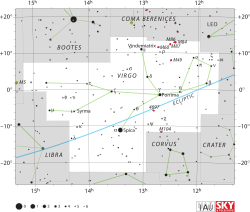Virgo (constellation)
| Constellation | |

|
|
| Abbreviation | Vir |
|---|---|
| Genitive | Virginis |
| Pronunciation |
/ˈvɜːrɡoʊ/, genitive /ˈvɜːrdʒᵻnᵻs/ |
| Symbolism | the Virgin |
| Right ascension | 13 |
| Declination | −4 |
| Family | Zodiac |
| Quadrant | SQ3 |
| Area | 1294 sq. deg. (2nd) |
| Main stars | 9, 15 |
|
Bayer/Flamsteed stars |
96 |
| Stars with planets | 29 |
| Stars brighter than 3.00m | 3 |
| Stars within 10.00 pc (32.62 ly) | 10 |
| Brightest star | Spica (α Vir) (0.98m) |
| Nearest star |
Ross 128 (10.94 ly, 3.35 pc) |
| Messier objects | 11 |
| Meteor showers |
Virginids Mu Virginids |
| Bordering constellations |
Boötes Coma Berenices Leo Crater Corvus Hydra Libra Serpens Caput |
|
Visible at latitudes between +80° and −80°. Best visible at 21:00 (9 p.m.) during the month of May. |
|
Virgo is one of the constellations of the zodiac. Its name is Latin for virgin, and its symbol is ♍. Lying between Leo to the west and Libra to the east, it is the second largest constellation in the sky (after Hydra). It can be easily found through its brightest star, Spica.
The bright Spica makes it easy to locate Virgo, as it can be found by following the curve of the Big Dipper/Plough to Arcturus in Boötes and continuing from there in the same curve ("follow the arc to Arcturus and speed on to Spica").
Due to the effects of precession, the First Point of Libra, (also known as the autumn equinox point) lies within the boundaries of Virgo very close to β Virginis. This is one of the two points in the sky where the celestial equator crosses the ecliptic (the other being the First Point of Aries, now in the constellation of Pisces.) This point will pass into the neighbouring constellation of Leo around the year 2440.
Besides Spica, other bright stars in Virgo include β Virginis (Zavijava), γ Vir (Porrima), δ Virginis (Auva) and ε Virginis (Vindemiatrix). Other fainter stars that were also given names are ζ Virginis (Heze), η Virginis (Zaniah), ι Virginis (Syrma) and μ Virginis (Rijl al Awwa).
...
Wikipedia
